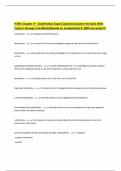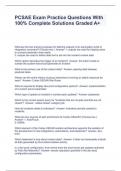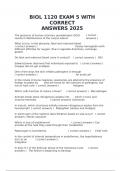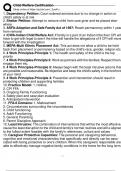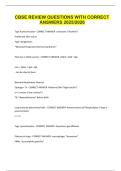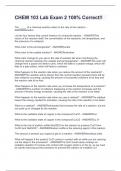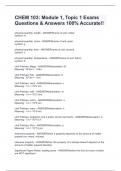Theory of development = a system of ideas that is based on evidence and attempts to explain, describe and predict
behavior and development.
Minor (1) vs. major theories (2) = (1) theories that only deal with specific, narrow areas. (2) theories that attempt to
explain large areas.
Motor development
Motor milestones = the basic motor skills acquired in infancy and early childhood: sitting, standing, walking etc.
[45] Maturational theory
Maturation of the central nervous system determines the development, independent of the environment.
Cephalocaudal trend = development that proceeds from head to foot.
Proximodistal trend = development that proceeds from the center of the body outwards to more peripheral segments.
[47] Dynamic systems theory
Development is a complex interaction between the system and the environment. 3 major factors are involved: (1) the
development of the nervous system; (2) the capabilities of the body; (3) environmental constraints and support.
[47] Research by McGraw The environment can influence motor development.
Twins were studied. (A) received training in varies skills, while (B) didn’t. A’s development accelerated.
Research that illustrates dynamic interplay
[48] Infant kicking Infants are able to change their pattern of interlimb coordination to solve a new task.
One leg is attached to a string that can move a mobile, later both legs are attached together.
[48] Infant reaching Infants need a stable posture before they can attain the goal of reaching successfully.
Several weeks before the onset of reaching infants acquired stable control over the head.
[49] Infant walking Infants do not have a fixed understanding of their own abilities.
Infants received a small or heavy weight. The ones with a heavy weight were more cautious before attempting to
walk.
Cognitive development
[51] Constructivism (Piaget)
Acquiring knowledge and skills is the result of learning to adapt to the environment and connecting new information
to what one already knows. Children are active agents in shaping their own development.
[51] Adapting (Piaget)
Children adapt to the world by assimilation and accommodation.
Assimilation = incorporating new experiences into existing schemes.
Accommodation = modifying existing schemes with new experiences.
[55] Information processing approach
Cognitive development proceeds in bottom-up fashion beginning with the input of information by the child and
building complex systems of knowledge from simpler origins.
Perception of causality = perception of the causal nature of interactions between objects and people.
Object unity = noticing an object as a whole when 2 parts of it are visible but the center is hidden by another object.
Connectionism = approach that developed form IPA in which computers are programmed to simulate brain action.
Social-cognitive development
[59] Social-constructivism (Vygotsky)
The social environment is a critical guiding factor in development. New skills are first learned in interaction with
other people before it is internalized.
Zone of proximal development = area of problems that can be solved with the help of others but not yet alone.
[59] Early behaviorism (Pavlov & Watson)
The child is passive in its development; the environment shapes the development.
Classical conditioning = behavior can be elicited a stimulus because of its learned association with another stimulus.
Law of effect = the likelihood of an action being repeated is increased if it leads to a pleasant outcome and vise versa.
[60] Behaviorism (Skinner)
The child has a more active role in its development. They operate on their environments based on reinforcements and
punishments.
Operant conditioning = shaping a human by reinforcing desired behavior and punishing undesirable behavior.
,[61] Social learning theory (Bandura) = application of behaviorism to social and cognitive learning that emphasizes
the importance of observational learning.
Ethology and evolution
[62] Ethological approaches
Emphasize the evolutionary origins of many behaviors that are important for survival.
Imprinting = when the young of animals follow the first moving objects they see.
Psychoanalytic theories
[66] Psychoanalytic theory (Freud)
There are 3 main personality structures: the id, the ego and the superego, which develop through psychosexual stages.
Id = responsible for an individual’s primitive instincts, such as eating and reproducing.
Ego = the rational thought that evolved to control the urges of the id in order to meet the demands of reality.
Superego = an individual’s morality, conscience, which is often in conflict with our id.
[66] 5 psychosexual stages (Freud)
Age Stage Key points
0-1 Oral Greatest satisfaction is derived from lips, tongue and mouth (pleasure from sucking).
1-3 Anal Toilet or potty training occurs (pleasure from controlling the anus).
3-6 Phallic Children obtain greatest pleasure from stimulating the genitals.
Oedipus, castration and electra complex.
6-adol. Latenc Sexual awakening goes into a resting period.
y
Adol.> Genital Sexual feelings become more apparent and urgent.
Humanistic theory
[69] Humanistic theory (Maslow)
Humans have a free will and are motivated to fulfil their potential (self-actualization). Maslow suggested that there is
a hierarchy of needs that determine our behavior.
(1) Physiological needs (2) Safety and security (3) Love and belonging (4) Esteem (5) Self-actualization.
Dimensions in developmental theories
[73] Dimensions
Nature vs. nurture: knowledge is innate vs. determined by the
environment.
Continuous vs. stages: development is gradual vs. it occurs in
stages.
Passive vs. active: child plays a passive role vs. an active role in
development.
Chapter 3: Nature-nurture Debate Theory
[83] Altricial (1) vs. precocial species (2)
(1) = when the young are incapable of moving around on their own and are dependent on their parents for food etc.
(2) = when the young are physically mobile and able from the moment of birth.
[84] Intelligence quotient (IQ)
Measures a person’s level of intelligence compared to a population of approximately the same age. (MA/CA) x 100
MA = mental age; level of mental ability relative to others.
CA = chronological age; someone’s actual age.
[87] Heritability
Describes how much of the variation of a trait is due to genetic differences in a population. When the heritability
coefficient is low we can speak of environmentalism; when it’s high we can speak of genetic determinism.
Environmentalism = people become who they are as a consequence of the learning and experiences they have had.
, Genetic determinism = people become who they are as a consequence of genetic inheritance.
Genetic contributions to cognitive development
[89] Familial resemblance = the resemblance between relatives whose genetic relationship to each other is known.
[91] Missing heritability = the failure to find any of the genes associated with cognitive abilities (such as IQ).
[91] Gene x environment interaction (GxE)
When different genotypes respond to similar environmental factors in different ways to create an individual’s
phenotype.
Dandelion children remain stable under all circumstances, while orchid children are vulnerable in negative
conditions, but can excel under positive conditions.
Epigenetics = changes in gene expression that are relatively stable during cell division (and sometimes generations);
the changes are independent of the genetic code itself.
Environmental influences on cognitive development
[94] Adoption study (Skeel)
Adopted children from nursery homes were followed for several years. One group stayed at the nursery home, while
the other was placed in adoptive homes. IQ scores of group 2 increased a lot, and later jobs were better.
Early deprived upbringing can have serious effects on development, which can be partly fixed by placement into
good adoptive homes.
[95] Adoption study (Romania)
Children who were adopted before 6 months made a more complete catch-up after entering adoptive homes.
The early adoption occurs, the better.
Environmental drift = change in developmental function that results from (and in direction of) changing environments.
[98] Flynn effect = an increase in the average IQ test scores over generations, causing them to have to be standardized.
Chapter 4: Prenatal Development Infancy
[111] Organogenesis
Organ formation in very early development, from cell division to about 8 weeks.
[113] Development of zygote
The zygote (fertilized egg) will make its way in the uterus. Cell division starts, and by day 3 the morula has
developed, marking the start of cell differentiation. From day 4-7 the embryo arises out of inner cells and it implants
in the uterus.
Development of the brain and spinal cord
[113] The embryonic period
Week 2: Gastrulation = formation of 3 germ layers by migration and differentiation of blastula cells.
Layer Develops into
Ectoderm Skin, hair, and (central) nervous system
Mesoder Muscles and bones
m
Endoderm Most other organs
Week 3: Neurulation = the formation of the neural plate
from the ectoderm, which folds and becomes the neural
groove, and then closes and becomes the neural tube.
Structure Develops into
Neural plate The brain
Neural tube Brain and spinal column
Week 4: Neurogenesis = the birth of new neurons; the embryonic body has the basic cranial-caudal organization
and the first primitive brain areas can be seen.
[115] Development of the cerebral cortex
Cerebral cortex = brain area that is associated with tasks such as memory, language, and the control of movement.
4 months: cells in the cerebral hemisphere begin to migrate and find their ultimate destinations in the 6 layers.



